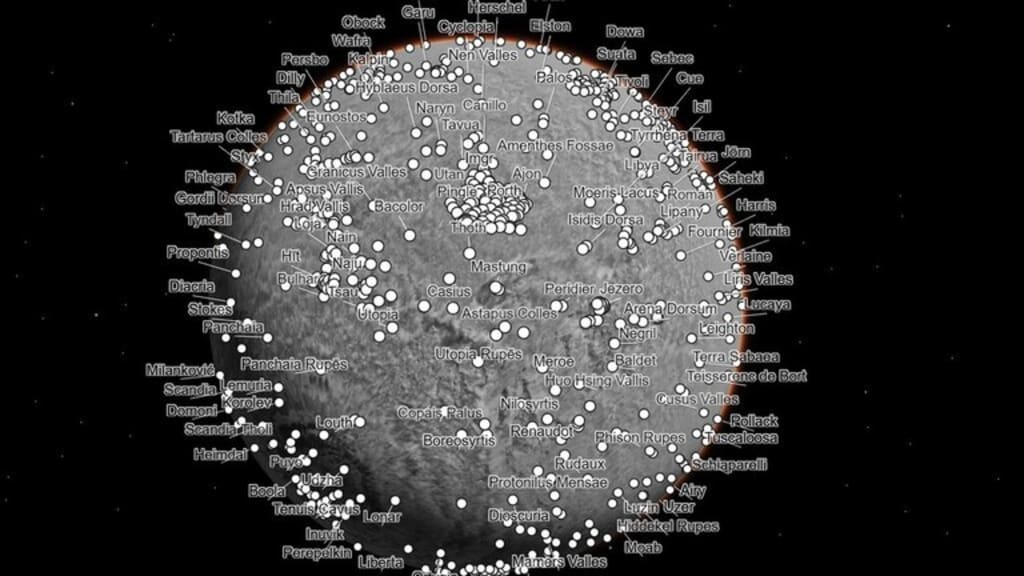An amazing interactive map that allows astronomy enthusiasts to explore Mars like never before
Although Mars is the closest planet to Earth, humans have to travel an estimated distance of 34.8 million miles to reach it.

Elon Musk recently predicted that humans would set foot on the Red Planet for the first time in 2029, while NASA seemed more conservative with its estimated schedule for a manned visit to the planet, predicting a landing sometime between 2030 and 2040.
Fortunately, there is an easy way to explore Mars now, from your home on Earth, without the hassle of traveling to space, as NASA has released a new interactive map that allows exploration of the many slopes and craters of Mars .
"I wanted something that was accessible to everyone," said Guy Dixon, the image-processing scientist who led the project. "School kids can use this now. My mom, who's 78, can use this now. The goal is to lower the barriers for people interested in exploring Mars."
The interactive map of the Red Planet was created at Caltech using 110,000 images taken by NASA's Mars Reconnaissance Orbiter.
These images cover approximately 270 square feet (25 square meters) of surface per pixel.
The resulting map captures a range of stunning geological features in incredible detail, including cliffs, impact craters, and tracks of 'dust devils'.
To explore the map on your own, use your computer mouse to zoom in and out. If you would like to explore any particular features, click on the feature name in the boxes at the bottom of the screen. The feature will then automatically zoom in on the map, like Olympus Mons, Zunil or Eberswalde.
Laura Kerber, a Mars scientist at NASA's Jet Propulsion Laboratory (JPL), provided feedback on the new map, saying: "I've wanted something like this for a long time. It's a beautiful art product and also useful for science."
Kerber used the map to explore the Medusae Fossae formation on Mars, a dusty region roughly the size of Mongolia.
While scientists still can't figure out exactly how it formed, Kerber hypothesized that it could be a pile of ash from a nearby volcano.
Using the new map, it is possible to zoom in on the area and explore ancient river channels winding through its landscape.
Other major areas highlighted on the map are Gale Crater and Jezero Crater, both of which are being explored by NASA's Curiosity and Perseverance for signs of ancient microbial life.
You can also cross Olympus Mons, the tallest volcano in the solar system.
"For 17 years, the Mars Reconnaissance Orbiter (MRO) has been revealing Mars like no one had seen it before," said Rich Zurek, mission project scientist. "This mosaic is a great new way to explore some of the images we've collected." Source: Daily Mail
Arianespace launches new European military satellites into space
Arianespace has announced plans to launch new military satellites into Earth orbit.
On the subject, the CEO of the company, Stephan Israel, said: "Next June, our company plans to launch two military satellites into space using an Ariane 5 missile, one for France and the other for Germany."
He added, "One of the first Ariane 6 missiles will also carry to earth orbits the third French satellite dedicated to Earth observation, which is also a military satellite. In addition to these satellites, our company's activity is mainly focused on launching civilian satellites."
Regarding the announcement of the launch date of the first new Ariane 6 missiles, he said: "I do not want to specify the exact month and day so as not to be misleading, but I can say that the launch mission will be carried out before the end of this year. We are working to implement this goal."
The Ariane 6 missiles that will be used in future launches are European space missiles of the new generation, and two versions will be launched: the light Ariane 62 version capable of transporting payloads of up to 5 tons into space, and the Ariane 64 version that will be able to transport 10.5 tons of payloads. to space orbits.
The first launch of this type of missile was supposed to take place in 2020, but the process was postponed several times due to the spread of the Corona pandemic and because of the difficulties encountered in the development process. Source: TASS
Russia is developing new missiles to launch its promising orbital station units
The Russian Khrunichev Center announced that it is developing new models of space rockets to launch sections of the promising Russian orbital station.
On the subject, the center's director, Alexei Vorochko, said: "Our center is developing Angara-A5M missiles to launch modules of the promising Russian orbital station (ROS)."
He added, "We have finished designing the draft designs for the Angara-A5M heavy space missiles, which have improved characteristics, and work is underway to develop the final designs for these missiles, as well as designs to adapt these missiles to the various units of the new station."
And in April 2021, the Russian Deputy Prime Minister at the time, Dmitry Borisov, had indicated that the technical situation of the sections of the International Space Station is not in the best condition, so Russia is focusing on developing its own orbital unit in the event that it abandons the International Station, and in October 2022, the Minister of Industry stated Trade in the Russian Federation Denis Manturov told reporters that the initial cost of establishing a promising Russian orbital station has become known.
And the "Ross Cosmos" Foundation had indicated earlier, "that the promising Russian orbital station may dispense Russia with the services of the International Space Station, and the basic unit of this station is supposed to be a scientific unit and an energy insurance unit, which is the same that Russia was planning to send." Towards the International Space Station in 2024. Source: Vesti
About the Creator
News Correct
Information WorldWide MORE INFORMATION






Comments
There are no comments for this story
Be the first to respond and start the conversation.